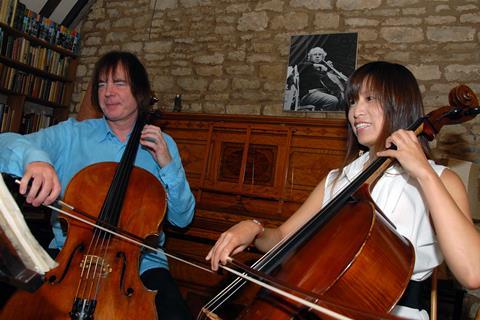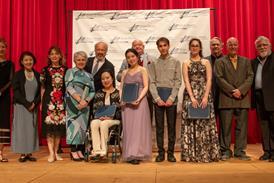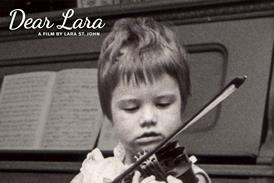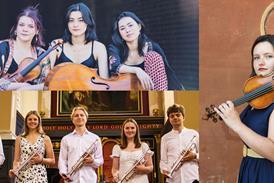Arnold’s Fantasy for Cello has provided years of musical satisfaction for the cellist. Here, Lloyd Webber reacquaints himself and audiences with the work, which was composed for him in 1986

Discover more Featured Stories like this in The Strad Playing Hub
It’s a classic case of role reversal as I find myself ‘back on the road’ again with my fellow-cellist wife Jiaxin. And - although no longer playing myself - it seems that I still get to carry the cello case! We are touring with a programme that we’ve created called ‘Bach Revealed’. I have always believed these kinds of ideas should develop naturally and this one grew out of lockdown.
I am sure Jiaxin would agree that she enjoys playing Bach’s Cello Suites more than anything else and - listening to her playing them every day - I began to conceive the idea of a programme where I would tell the extraordinary history of the Suites before she played them. Bach doesn’t need much revealing to readers of The Strad, but the story of how his Cello Suites emerged from two hundred years of complete obscurity to become some of the most iconic works in the classical repertoire remains fascinating to audiences.

As a complete contrast to Bach we decided to add Malcolm Arnold’s Fantasy for Cello, which he composed for me in 1986, to the programme and it was enlightening to revisit the work once again.
I first met Malcolm Arnold in 1968. It was the summer before I entered the Royal College of Music: I was 17 and Malcolm was conducting a youth orchestra course I had signed up for in Vienna. This was chiefly memorable for Malcolm being locked up in his room by the organisers after he had fallen down drunk in the middle of a live TV broadcast which had been hastily arranged to promote the concert as it wasn’t selling well. Evidently his appearance did have a beneficial effect on ticket sales, as I remember the concert, which included Arnold’s Second and Dvořák’s Seventh symphonies, being completely sold out!
By the time I witnessed the première of his Trumpet Concerto in 1983, Arnold’s music could scarcely have been less fashionable, yet I thought it was a good enough piece to ask him if he would write me something for solo cello. He readily agreed while refusing to accept a commission fee, explaining that his music was ‘a gesture of friendship’
As Arnold had never written for cello before I had no idea what to expect. But I was more than happy with what arrived. Sir Charles Groves got it right after he heard me play the first movement as an encore after we had performed Haydn’s C major Concerto: ’You’ve got the real Arnold there.’
Cast in seven movements played without a break, the opening Andantino is unmistakeably Arnold – as indeed is the whole work. The intensity of expression can be heard in the opening four bars, through which the dynamics range from forte to fortissimo to mezzo forte to pianissimo – Arnold never did things by halves! Vivace, with its superficial jocularity, is perhaps the result of my telling Malcolm how much I liked the third movement of his Fifth Symphony with its side-by-side juxtaposition of jollity and despair. (I always believed in letting composers know what you liked in their music rather than asking for something specific.) Lento introduces the almost minimalist turn that Arnold’s music had taken by this point, with mournful phrases repeated several times, then immediately repeated either in another key or up or down an octave. Alla marcia is exactly that – a characteristically grotesque rhythmic march, well written for the instrument.
Allegretto is the most extraordinary movement of all and it was well spotted by the director Tony Palmer, who asked me to play it for his masterly film Toward the Unknown Region. Played pizzicato throughout, Arnold really could be taken (mistaken?) for a minimalist composer with his constant repetition of insistent - and in this case disquieting - ideas. This remarkable movement is succeeded by a second Lento in which depths of despair are matched by a certain calm resignation. It is a hard movement to capture, which resulted in one of my most challenging moments in a recording studio – in this case Henry Wood Hall. Every time I felt that I had plumbed sufficient depths the sun would come out, causing annoying materials in the roof to expand with ensuing noise. Then the clouds would come and the noises would resume as the roof contracted. I wondered how many times I could feel such degrees of despair. It was a depressing afternoon all round! Finally, the opening Andantino returns to conclude this impressive addition to the solo cello repertoire.
More than thirty years since its composition I am happy to have become re-acquainted with this remarkable piece. Completely unprompted by me, my dear, much-lamented, friend Michal Kaznowski had begun to teach it to his many pupils and I can understand why. Of moderate difficulty, yet musically rewarding, Arnold’s Fantasy has much to offer to players and listeners alike.
Julian and Jiaxin Lloyd Webber’s summer festival tour continues on 16 July at the Lichfield Festival and 18 July at the Kings Lynn Festival. www.julianlloydwebber.com
Read: ‘There’s a lot of teasing. Even his kids tease me’ - Double Acts: Colin Carr and Thomas Sauer
Read: ‘It’s a powerful experience to perform the cycle’: cellist Guy Johnston on Beethoven Cello Sonatas
Read more Featured Stories like this in The Strad Playing Hub
The number one source for playing and teaching books, guides, CDs, calendars and back issues of the magazine.
In The Best of Technique you’ll discover the top playing tips of the world’s leading string players and teachers. It’s packed full of exercises for students, plus examples from the standard repertoire to show you how to integrate the technique into your playing.
The Strad’s Masterclass series brings together the finest string players with some of the greatest string works ever written. Always one of our most popular sections, Masterclass has been an invaluable aid to aspiring soloists, chamber musicians and string teachers since the 1990s.
This year’s calendar celebrates the top instruments played by members of the Australian Chamber Orchestra, Melbourne Symphony, Australian String Quartet and some of the country’s greatest soloists.













































No comments yet